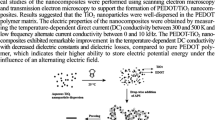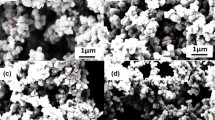Abstract
A conducting polymer composite, poly (3-octylthiophene)/titanium dioxide nano-composite was first synthesized through the ultrasonic method. The results from X-ray diffraction, X-ray photoelectron spectroscopy and infrared spectroscopy show that there is chemical interaction in the composite, which indicates that TiO2 was successfully coated by poly (3-octylthiophene) molecules. The energy gap of the poly (3-octylthiophene)/titanium dioxide composite is lower to 0.65 eV; and it also shows that the optical performance of the new material is far superior than POT or TiO2 separately, by Ultraviolet–visible spectra and fluorescence spectroscopy.








Similar content being viewed by others
References
R.D. McCullough, The chemistry of conducting polythiophenes. Adv. Mater. 10, 93–116 (1998)
N. Hebestreit, J. Hofmann, U. Rammelt, W. Plieth, Physical, electrochemical characterization of nanocomposites formed from polythiophene, titanium dioxide. Electrochim. Acta 48, 1779–1788 (2003)
C.L. Huisman, A. Goossens, J. Schoonman, Preparation of a nanostructured composite of titanium dioxide, polythiophene: a new route towards 3D heterojunction solar cells. Synth. Met. 138, 237–241 (2003)
G.D. Sharma, P. Suresh, S.Kumar Sharma, M.S. Roy, Optical and electrical properties of hybrid photovoltaic devices from poly (3-phenyl hydrazone thiophene) (PPHT) and TiO2 blend films. Sol. Energy Mater. Sol. Cells 92(6), 1–70 (2008)
R. Sugimoto, S. Takeda, H.B. Gu, K. Yoshino et al., Preparation of soluble polythiophene derivatives utilizing transition metal halides as catalysts and their property. Chem. Express 1, 635–638 (1986)
C. Visy, G. Bencsik, Z. N’emeth, A. V’ertes, Synthesis and characterization of chemically and electrochemically prepared conducting polymer/iron oxalate composites. Electrochim. Acta 53, 3942–3947 (2008)
J.C. Xu, W.M. Liu, H.L. Li, Titanium dioxide doped polyaniline. Mater. Sci. Eng. Biomimetic. Supramol. Syst. C 25, 444–447 (2005)
J.F. Moulder, W.F. Stickle, P.E. Sobol, K.D. Bomben, Handbook of X-ray Photoelectron Spectroscopy (Physical Electronics, Inc, Bellingham, 1995)
E.T. Kang et al., Surface modifications of poly (3-alkylthiophene) films by graft copolymerization. Macromolecules 25, 6842–6848 (1992)
M.R. Karim, C.J. Lee, M.S. Lee, J. Polym. Sci. A 44, 5283 (2006)
J.E. Mark, Polymer Data Handbook (Oxford University Press, Oxford, 1999)
A.O. Patil, A.J. Heeger, F. Wudl, Chem. Rev. 88, 183 (1988)
L.G. Tong, X.G. Qian, J.Y. Wang, Funct. Mater. 33, 5 (2002)
Acknowledgments
The work was supported by the National High Technology Research and Development Program of China (863 Program) under Grant no. 2006AA03z412, and the Research Fund for the Doctoral Program of Higher Education (No. 20050010014).
Author information
Authors and Affiliations
Corresponding author
Rights and permissions
About this article
Cite this article
Han, Z., Zhang, J., Yang, X. et al. Synthesis and photoelectric property of poly (3-octylthiophene)/titanium dioxide nano-composite material. J Mater Sci: Mater Electron 21, 554–561 (2010). https://doi.org/10.1007/s10854-009-9956-6
Received:
Accepted:
Published:
Issue Date:
DOI: https://doi.org/10.1007/s10854-009-9956-6




